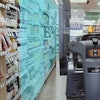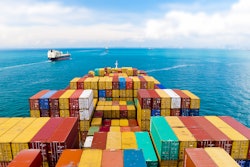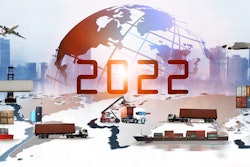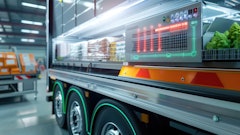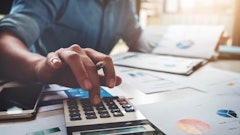
When 2021 hit, the world was ready for the New Year. Even if it brought with it a New Normal -- new way of doing business, a new way to shop for groceries and more -- the turning of the calendar meant putting a year of supply chain disruptions, restaurant closures and constant pivoting behind us.
But, then, on March 23, a stranded Evergreen container ship blocked navigation in Egypt’s Suez Canal, setting the stage for what would be a slew of supply chain disruptions after supply chain disruptions.
Suddenly, 2021 was quickly becoming a mirrored reflection of the year prior.
Then came the ransomware attacks, internet outages, container ships stuck at bay, bridge closures, driver shortages, ingredient shortages, natural disasters and more.
The hits just kept on hitting.
And, industry experts are already showing signs of struggle for 2022 into 2023, as routes to import/export remain clogged, ports continue to be backed up, cost of doing business increases and the labor shortage exists.
That’s because supply chains are messy. And, they’re only going to get worse before they get better.
In Food Logistics’ Nov/Dec 2021 issue, editor-in-chief Marina Mayer talks with several industry experts about the state of the supply chain and what’s in store for 2022.
Here’s an interview with C. John Langley Jr., clinical professor of supply chain management and director of development for Center for Supply Chain Research at Penn State University, who says that the more progress that can be made on the pursuit of end-to-end supply chain visibility, the better, with excerpts publishing in Food Logistics’ Nov/Dec 2021 issue. [CLICK HERE to read the article in full].
Food Logistics: 2021 started off with supply chain disruption after supply chain disruption. From the Suez Canal blockage and natural disasters to ransomware attacks and an industry-wide labor shortage, the supply chain industry is having to prove its resiliency over and over again. Looking into 2022, what does the state of the supply chain look like?
C. John Langley Jr.: The inability to manage supply and demand on a global basis is clearly becoming more acute. Considering the confluence and complexity of factors that are responsible for the unprecedented shortage of needed goods, current conditions are likely to intensify and become more challenging throughout 2022.
Food Logistics: The cold food chain continues to face a host of risk/security challenges. What can companies be doing now to adapt for the future?
Langley Jr.: Unfortunately, the risk outlook for cold food chains will be impacted by the global volatility of markets, sources and prices of energy resources needed to maintain desired levels of temperature. While significant benefits may be related to the pursuit of environmental sustainability, the net results are likely to include adverse impacts on the availability and cost of energy resources for businesses and consumers.
Food Logistics: In terms of transportation, what are some of the trends you’re seeing for 2022? How do emerging technologies like blockchain, Internet of Things, cloud-based, etc. play a role in the evolution of transportation in the cold food chain?
Langley Jr.: The availability of capable transportation and supply chain services will be dependent on the ability of provider and customer organizations to effectively identify and manage game-changing technologies such as blockchain, IoT, cloud capabilities, etc. While there always will be a need for physical movements in our supply chains, core competencies already have expanded to include excellence in utilizing appropriate technologies to facilitate the effective, efficient and innovative management of transportation and supply chain services.
Food Logistics: Let’s talk supply chain visibility. What is your company – or what should companies – be doing to improve their own supply chain visibility?
Langley Jr.: As a starter, supply chain visibility will be increasingly regarded as a necessary capability for success. The more progress that can be made on the pursuit of end-to-end supply chain visibility, the better. Dependence on robust supply chain control towers will be essential to the future success of supply chains.
Food Logistics: The labor shortage is a real thing, and it’s impacting several facets of the supply chain. What is your company – or what should companies – be doing to hire, onboard and retain good quality supply chain workers?
Langley Jr.: Although COVID-19 bears some responsibility for the shortage of good quality supply chain workers, future progress in this area will be highly dependent on the lowering of societal welfare programs that appear to be a disincentive for many potential workers to seek employment. While many companies will need to commit to sometimes uneconomical and impractically high wage levels for supply chain employees others will choose to rely more so on the use of technology and automation to replace the need for workers in the supply chain.
Food Logistics: The COVID-19 pandemic put extra emphasis on food safety and worker safety. What is the state of food safety and worker safety going into the New Year?
Langley Jr.: This issue is of great concern, particularly as companies have less talent to deal with food safety and worker safety. This is an area that will require the setting of high standards for diligence, and a strong commitment to assuring related objectives continue to be upheld.
Food Logistics: When it comes to grocery retail shopping and/or foodservice establishments, what are some trends you see sticking around post-pandemic, and which ways of doing business will somewhat go away?
Langley Jr.: These organizations will need to figure out how to deal with increasingly deteriorating abilities to provide acceptable in-stock levels for their consumers. Also heavily impacted by challenges in hiring employees, a likely trend will be the substitution of automation when possible to lessen the dependence on the hiring of employees.
Food Logistics: What are some things not addressed above that may be pertinent to our readers?
Langley Jr.: While the pursuit of environmental sustainability is front and center for many business organizations, there will be instances where this priority conflicts with the pursuit of economic sustainability. While this clearly is a highly politicized and highly charged issue, caution needs to be exerted at least in the short-to-intermediate-term to avoid making poor decisions that may have negative and sometimes dramatic impacts on businesses and consumers.
[CLICK HERE to read the article in full].



